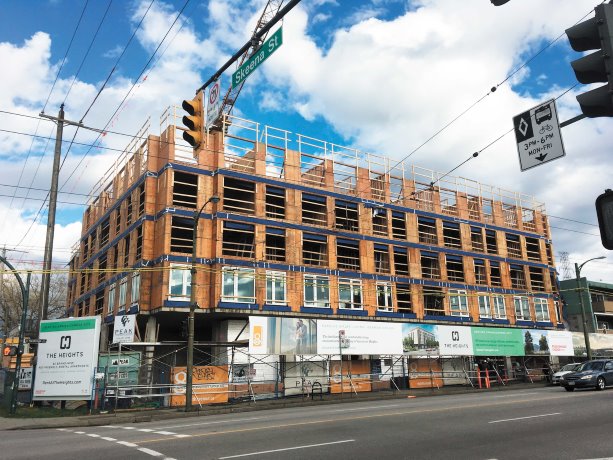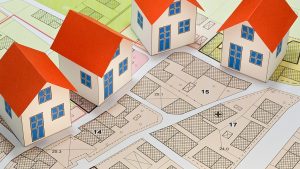A new low-carbon, ultra-energy efficient building called The Heights is under construction in Vancouver. The six-storey, 85-unit market-rental apartment project at 388 Skeena St. aims to be Canada’s largest building certified to the internationally recognized passive house standard.
The City of Vancouver and the Pembina Institute are eager to see passive house projects like this take hold.
The Heights is being developed by Eighth Avenue Development Group and built by Peak Construction. Doug Wilson, president of Peak, said he got involved with the project when he was approached by Eighth Avenue president Ed Kolic.
The discussion of passive house started with Cornerstone Architecture principal Scott Kennedy early in the process. Since Kennedy is also an engineer, he and Wilson were able to have detailed discussions about the logistics of building to passive house standards.
"He and I were able to speak well together about different factors and ultimately he really sold me on the idea of passive house as being a good, viable option," Wilson said.
"Part of the challenges included ensuring the subtrades would understand what we are trying to do here. Part of it was trying source product because passive house is not a widespread thing yet."
Peak solved this partly by putting some of its staff through passive house construction trades training at the British Columbia Institute of Technology (BCIT).
"We have taken on a lot of the work internally and learned how to do it ourselves rather than rely on subcontractors," Wilson said.
"The industry is already shifting to high-performance buildings and this is just one type of high-performance building and more and more subs and suppliers are coming into the market and realizing that high-performance buildings are the wave of the future."
This is especially true in Vancouver, which is poised to implement its new Zero Emissions Building Plan, he added.
The B.C. and federal governments also have signalled changes are coming to building and energy efficiency regulations and policies as part of each jurisdiction’s plans to slash carbon pollution. These changes will result in ultra-energy efficient buildings becoming the norm by 2030, which will reduce the cost of utility bills for residents by as much as 80 per cent.
Kennedy, who is also chair of the board for Passive House Canada, said the government needs to do more to aid passive house construction as the market is in the early stages of adoption.
"What we need is for some government subsidies, for the early adopters," he said. "We need to create excellence in building. We can’t do it if we don’t have the products in the market place and we can’t do that if there isn’t a demand."
Others are working to spur passive house buildings through supporting research.
This month, the Pembina Institute launched a report Accelerating Market Transformation for High-Performance Building Enclosures. It tracks the rapid growth of passive house buildings, assesses their costs and benefits and sheds light on how public policy can encourage its adoption.
The report notes the number of passive house units in North America has quadrupled in the last year, from 500 to over 2,000 units.
A quarter of the units (600) are in Vancouver alone, making the city a hotbed for the North American expansion of these green buildings which dramatically reduce carbon pollution and energy use, enhance comfort and durability and boost the clean economy.
Buildings are responsible for nearly one-quarter of Canada’s carbon pollution and a third of U.S. emissions.
By the end of 2016, North America will have nearly two million square feet of certified passive house buildings, three times more than in 2015.
The City of Vancouver’s Zero Emissions Building Plan calls for a 90 per cent reduction in emissions from new buildings by 2025 and zero emissions for all new buildings by 2030.
"In less than 10 years, near-zero emission homes and buildings will be commonplace in Vancouver and elsewhere. Recent government initiatives — including Vancouver’s Zero Emissions Building Plan and B.C.’s climate plan — call for new buildings to achieve near-zero emissions by 2030," said Karen Tam Wu, director of the buildings and urban solutions program at the Pembina Institute.
"We expect the federal framework for clean growth and climate change to complement this objective. These forward-looking policies will protect our communities, support job creation and strengthen our low-carbon economy."

1/2
The Heights is a six-storey condo project being developed by Eighth Avenue Development Group in Vancouver. At 65,000-square-feet it will be the largest residential building built to passive house standards. Residents will see energy savings of up to 80 per cent.
Photo: Russell Hixson
2/2
A labourer continues work on The Heights











Recent Comments
comments for this post are closed